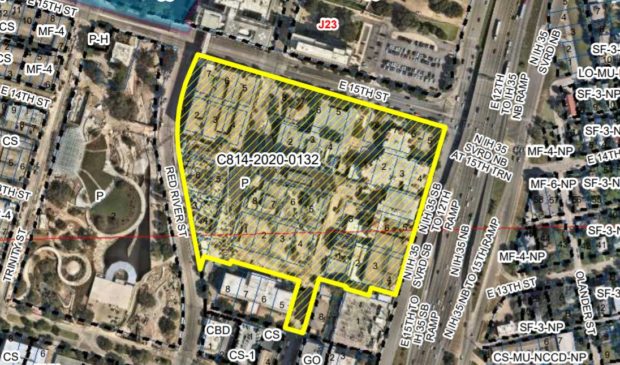Council gives final approval for dense development on Brackenridge site
Wednesday, June 16, 2021 by
Jo Clifton After years of planning and negotiations, City Council gave final approval Thursday for Planned Unit Development (PUD) zoning for the Central Health property at 15th and Red River streets – the former Brackenridge Hospital site. The vote, which was on Council’s zoning consent calendar, was unanimous.
Under the new regulations, the property will have Central Business District site regulations and a maximum floor area ratio of 25:1, allowing for a tall and dense mixed-use development. That dense development will generate more funding for Central Health, which provides medical care for about one in nine Travis County residents. Projects on the site are required to achieve a three-star Green Building rating and must provide pedestrian-oriented uses along the new and relocated Red River Street.
Central Health President Mike Geeslin pointed out that revenue from the new development will give Central Health a new source of funds so that the health care district is not solely dependent on property tax to fulfill its mission. Geeslin said in a news release that the PUD zoning “is a critical and long-awaited milestone in the redevelopment of this valuable and important property.”
This year, Central Health is taxing Travis County properties at a little more than 11 cents per $100 of property value. According to the district’s website, “Central Health has long maintained the lowest tax rate of any of the major urban hospital districts in Texas – 11.0306 cents per $100 valuation – a trend that continues into Fiscal Year 2021. Central Health also maintains the lowest rate of any of the Travis County taxing entities – Austin ISD at 56 percent of the total tax bill, City of Austin at 21 percent, Travis County at 14 percent, Austin Community College at 5 percent, and Central Health at 4 percent.”
The first developer on the site is the 2033 Higher Education Development Foundation, created to support UT Austin. According to the news release, the foundation, which has a 99-year ground lease, has already begun construction on a 17-story office building expected to open next year. Central Health estimates that the foundation will pay the district about $430 million over the life of the lease. The foundation paid Central Health more than $1.5 million for two tracts of land in 2020. Ascension Seton paid Central Health more than $9.3 million in FY 2020 to lease an office building called the Clinical Education Center and a parking garage connected to Dell Seton Medical Center.
Zoning of the old Brackenridge site is part of a master plan that includes straightening Red River Street to improve mobility around the property and provide better connectivity to the new Waterloo Greenway, which is next to it.
Sherri Greenberg, chair of the Central Health Board of Directors, commented, “The community helped create the master plan, which provided a clear vision for this development. We listened when residents told us they wanted a vibrant hub for healthier living that is easily accessible on foot, bike, public transit or car. The community wanted a development that included space for health care services, medical research and innovation, and creates a sense of community. We’re eager to move this project forward.”
In December 2014, Council directed staffers to create an innovation zone and establish land use regulations for the site. In November 2019, staffers initiated a code amendment, with the Planning Commission approving that amendment in December 2019. At the time, the commission recommended an additional condition to require 100 affordable residential units on the property if an eventual developer wanted to build multifamily units. According to backup provided by the city, Council was set to review the zoning in September 2020; however, Council members determined that PUD zoning was the best way to accomplish the city’s goals, and a PUD application was filed in November 2020.
The Austin Monitor’s work is made possible by donations from the community. Though our reporting covers donors from time to time, we are careful to keep business and editorial efforts separate while maintaining transparency. A complete list of donors is available here, and our code of ethics is explained here.
You're a community leader
And we’re honored you look to us for serious, in-depth news. You know a strong community needs local and dedicated watchdog reporting. We’re here for you and that won’t change. Now will you take the powerful next step and support our nonprofit news organization?










